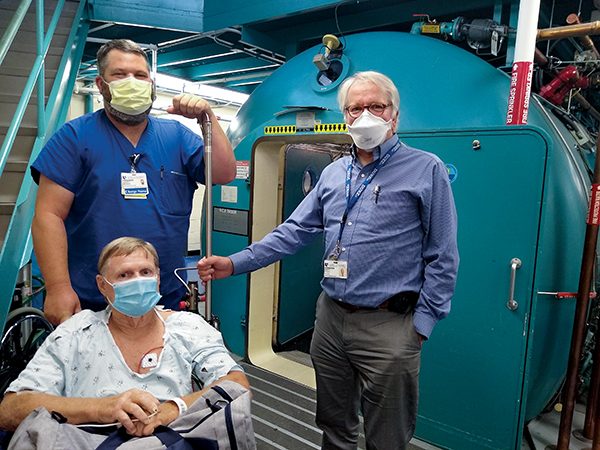HAVING DONE THOUSANDS OF DIVES since I started in 1964, primarily off the coast of North Carolina, the shipwrecks and dive profiles there are familiar. Overall conditions couldn’t have been much better on this particular day — calm, clear seas with barely a current. We planned on two reverse profile decompression dives at an offshore location. Since I dive a lot each season, I carry two dive computers — one set to my actual breathing gas mixture of 30 percent nitrox and the other set to 21 percent air, which I follow for a more conservative decompression.
My ascent was normal, and I did a safety stop before ascending to the surface. After climbing the ladder, getting back on the boat, and removing my gear, I felt tightness in my upper sternum and chest. I rinsed off with fresh water and removed my wetsuit, but the feeling did not go away. The sensation mimicked a decompression sickness (DCS) hit I had in 1990, so I began to think it had happened again.
I immediately went on 100 percent oxygen with a nonrebreather mask. The feeling in my chest went away within a few minutes, but my lower right leg began to tingle, followed by my left leg. I stayed on oxygen for the trip back to shore, which helped lessen the tingle in my legs. On shore I began having trouble walking and felt very unsteady. My next move was to call the DAN hotline.
I described what was happening to the medic, who advised me to go to the local emergency room to get checked out, especially for cardiac issues since I had felt chest tightness. Although we live within four hours of the Duke University hyperbaric chamber and I wanted to go straight there, I understood that the closest ER was a necessary first step.
The ER was not busy that afternoon. The doctor listened to my symptoms and understood I wanted to get to the chamber. He called the DAN hotline and spoke with the medic, who connected him with the Duke chamber, and they coordinated what would happen next. My only critique of the ER was that they put me on a nasal cannula instead of a nonrebreather mask, but they immediately switched me to the mask when I asked. Being your own patient advocate is important.

Even when using conservative settings on your dive computer, remember that it still only predicts your inert gas loading and decompression stress. Always complete your decompression obligations and treat seriously any symptoms while diving.
Getting to Durham seemed to take a long time, but in retrospect it went as smoothly as possible. The tests indicated I was likely suffering from spinal DCS, which explained why my legs were affected. The ER doctor told me they were arranging helicopter transport, which would fly low to avoid altitude exacerbating my symptoms. After a short weather delay, the helicopter from Duke Life Flight got underway and arrived just before 11 p.m. The kind, professional crew packaged me up on their stretcher and briefed me on the flight. It took just over an hour to reach the ER at Duke Medical Center. While underway, my family could view the helicopter’s flight path on their phones, so my daughter watched it fly by in the distance as it passed near her house.
Upon reaching the ER at Duke, they checked me in, examined me, and transferred me to the hyperbaric chamber within an hour. My first chamber ride was the standard U.S. Navy Treatment Table 6. When that finished early the next morning, they released me for a few hours before a second, shorter ride after lunch.
To be thorough, the doctor ordered an MRI that evening to evaluate the area where the DCS hit affected me. I had a third chamber ride — the shortest yet — the following day, along with seven other patients receiving medical hyperbaric treatment. I was impressed with the hyperbaric capacity and capability available at Duke. The chamber I was in that morning could accommodate eight patients and two attendants. After the third ride, the dive doctors released me. My symptoms were about 85 percent resolved by then, which the doctors assured me was normal. They said I would see continued improvement over the following weeks and months.
My first dive was to 70 feet (21 meters), and I got DCS on the next day’s dive to 110 feet (33.5 meters). I followed my computers, utilizing the extra cushion that my air computer provides. I could have been a bit dehydrated, and I have some arthritis in my lower back (which the MRI confirmed). Other than that, it’s hard to pinpoint why I got bent.
DAN dive accident insurance has been a must-have for me since shortly after my first DCS experience in 1990. Back then my symptoms resolved with oxygen, but I was concerned enough to get checked out at Duke. By the time I did, 48 hours had passed, and it was too late for the chamber.
In 2022 I did not hesitate to start on oxygen, and I was in the chamber within 14 hours of symptom onset. I expect to keep improving, and I have a follow-up assessment in a few months.
DAN was pivotal in streamlining the process. They explained the situation, coordinated everything with the local ER, and got me where I needed to be. Considering the circumstances, my experience with DCS couldn’t have gone more smoothly because DAN was there for me. AD
© Alert Diver — Q3 2022